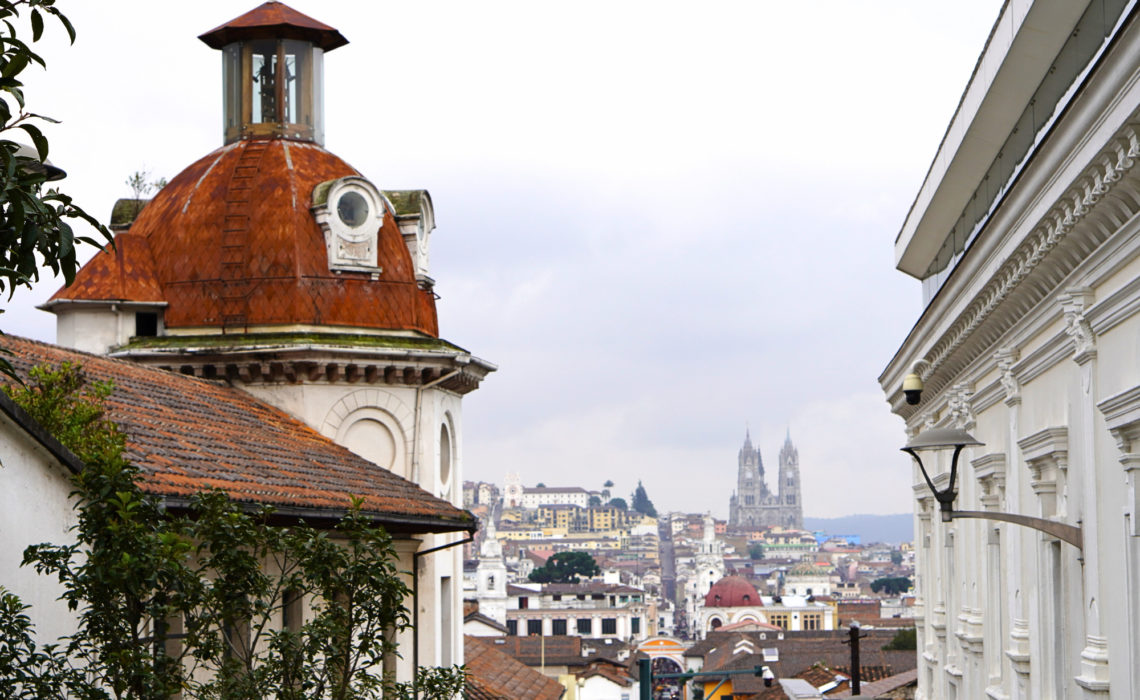
I found myself in Quito, the capital city of Ecuador, for the wedding of a good friend and work colleague in March 2022. Since I booked my trip at the very last minute, I did not find any direct flights, so I landed in Quito after midnight after a layover in Mexico City. I took a cab from Mariscal Sucre Quito International Airport, and reached the Reina Isabel hotel, where I was staying, in less than an hour, after paying about US$26. The local currency is USD and cabs from the airport accepted credit cards – a relief since I almost never carry cash on trips.
Quito is located in a valley on the eastern slopes of Pichincha, an active stratovolcano in the Andes, at an elevation of 2,850 m, making it the second-highest capital city in the world. The altitude difference hit me as soon as I reached the hotel. Even lying in bed, I felt breathless. The city is known for its stunning colonial architecture, vibrant culture, and breathtaking views. Quito is surrounded by volcanoes and is home to numerous parks, museums, and churches, making it a perfect destination for sightseeing and soaking up local history and culture.
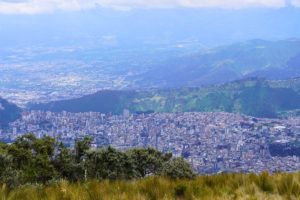
The next day after my landing, I roamed around the city trying to find a store to purchase a local sim card, which apparently was called ‘chip’. No employee in any of the stores I entered spoke English so I was on ‘Google translate’ the entire time trying to explain what I was looking for. I was directed to a pharmacy to find a sim card, but my attempt to purchase one wasn’t successful since they needed cash which I wasn’t carrying with me. I dropped my search for a sim card temporarily to meet with my friend and bride-to-be for some sightseeing which included special access to some of the sites.

Quito Old Town
We started with our first stop at the Basilica of the National Vow, a Roman Catholic church located in the historic center of the city and the largest neo-Gothic Basilica in the Americas. Our guide was sharing the history and important details while I, as always, was preoccupied with taking pictures. We then headed to the Old Town, which is a UNESCO World Heritage Site and home to some of the city’s most beautiful colonial buildings and churches, such as the Church of the Society of Jesus, the Church of San Francisco, and the Cathedral of Quito. The intricate details and opulent decorations inside the churches were truly breathtaking and gave the impression that they were the result of King Midas’ touch.

San Francisco Museum and Convent
The interior gardens of San Francisco Museum and Convent (Museo Fray Pedro Gocial) were one of the most stunning havens, where we spent some time teaching new English words to three colorful parrots. The winding paths and tall, slender palm trees in the museum’s gardens created a sense of mystery and seclusion as if you had stumbled upon a hidden oasis in the midst of a bustling city. The gardens seemed like a perfect escape from the surrounding colonial architecture, offering a tranquil and picturesque setting to allow us to literally catch our breath (pun intended).
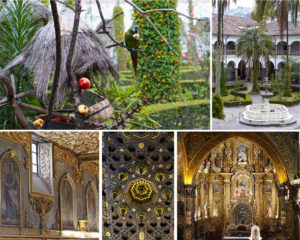
Casa del Alabado Museum of Pre-Columbian Art
Another interesting stop was Casa del Alabado Museum of Pre-Columbian Art, located in a colonial house built in the 17th century during the Spanish Colony. It houses a collection of over 5,000 archaeological pieces, 500 of which are on permanent display. In addition to seeing some intriguing sculptures of Pre-Columbian civilizations, we also listened to one of our guides playing what looked like a ceramic-based musical instrument. It was a type of flute that looked like a whistle bottle and produced sound only with the help of water, creating the impression of birds chirping in a forest or thick vegetation.
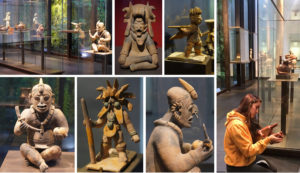
La Compañía de Jesús Church
We ended the night at the Church and Convent of San Ignacio de Loyola de la Compañía de Jesús de Quito, also known simply as La Compañía. The façade of its main temple is entirely carved in volcanic stone. Following a brief tour of the church, we congregated at the reception area to partake in the festivities. Live music, courtesy of a skilled saxophonist, filled the air as we indulged in the traditional celebratory beverage, known as Canelazo. This exquisite concoction is composed of aguardiente, a sugarcane-derived alcohol, combined with sugar or panela, and infused with cinnamon-infused water, also known as agua de canela.

The best part was sipping our drinks at the church’s dome and roaming around the rooftop admiring the magnificent view of two green domes with the mosaic-style decorations under purple light; the perks of being guided by a local, my friend, with special access to these historical sites.
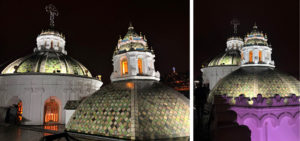
Guapulo Colonial Church
The following day was entirely dedicated to the wedding, which was the main reason behind this trip, and our first stop was the Guapulo Colonial Church (Iglesia de Guapulo). As the taxi took us to the church through the cobbled scenic streets of Guapulo, I knew I wanted to return and explore this artsy and bohemian neighborhood. As we arrived at the church, we were given paper cones with rose petals. The ceremony was heartwarming, leaving us with a lingering feeling of awe and reverence, emotions that were amplified by the heartfelt vows of the couple and the ‘Ave Maria’ song by Franz Schubert – a truly transcendent experience.
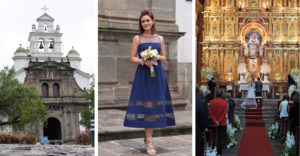
La Palma Polo Club
After we showered the newlyweds with rose petals, we headed to the reception at La Palma Polo Club, a gorgeous location overlooking the polo field and a lake. The evening started with a few cocktails before heading to our seats. The décor had a forest-feel theme with flowers hanging over our tables, which gave the feeling of being in the Amazon rainforest, which wasn’t in fact so far from there.
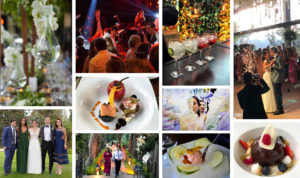
Following a series of emotional speeches and a delectable meal, including my personal favorite, the initial dessert, a sorbet presented in an ice cup, we gathered around the newlyweds. Indoor fireworks illuminated the space as the couple shared their first dance together. The night was predominantly remembered for our endless dancing to mix of popular songs and classic hits in a concert-like setting, and as the night progressed and the lights dimmed, everyone was handed out fluorescent lights, bracelets and eyeglass-shaped neon ornaments, and LED balloons, which added a fun and playful element to the dance floor.
Quito TelefériQo
The day after the wedding, we headed to the Quito TelefériQo, one of the highest aerial lifts in the world running from the edge of the city center up the east side of Pichincha Volcano to lookout Cruz Loma. The ascent from 3,117 m (10,226 ft) to 3,945 m (12,943 ft) took roughly twenty minutes. After acclimating to the high altitude and enjoying the scenic view, we embarked on a strenuous hike up a seemingly never-ending incline. The weather and scenery were constantly changing, making the hike even more memorable.
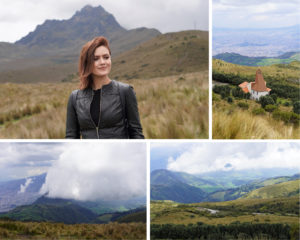
We made a long stop at the swings on top of Pichincha Mountain to snap some pictures. From the swings, we enjoyed a 360-degree view of the surrounding landscape, with the city stretching out below us and the green mountains rising up all around. The experience was a mix of adrenaline rush with a sense of peace and stillness as you take in the surrounding beauty.

As we continued our hike, we encountered llamas and alpacas, horses, and traditional huts. Approaching the peak, we would stop every ten steps to catch our breath. Lacking hiking shoes didn’t make it any easier either. Although it was clear that a storm was approaching, it did not deter us. Overall, it was a miracle that I made it back unscathed without proper shoes, and minutes before it started pouring hail. Taking the lift back to the city was an unforgettable experience. It was raining cats and dogs and the surrounding mountains were shrouded in mist contributing to a mix of the thrill of being suspended high above the city with the comfort and coziness of being inside.
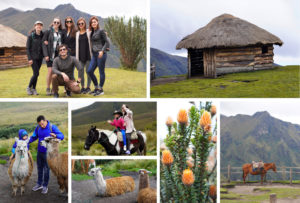
Culinary, Artistic and Other Unexpected Experiences
After about five days at the Galapagos islands, we returned to Quito for a couple of days to catch up on the last of our sightseeing. We chose to stay at Hotel Rio Amazonas this time. Despite making a last-minute reservation, we ended up at Zazu, one of the highest-rated restaurants on TripAdvisor. They were so responsive that we booked through Google chat. We were seated right outside the wine cellar, an about six meters high climate-controlled circular room. The atmosphere was warm and inviting, with a cozy and intimate ambiance. The diverse menu of dishes featured traditional Ecuadorian cuisine with a modern twist. We tried a bit of everything, including the Angus tartar, the seabass, the clams, the prawns, and the short rib. The dishes were vibrant and visually appealing, and crafted with fresh, local ingredients that showcased the rich flavors and textures of the region.
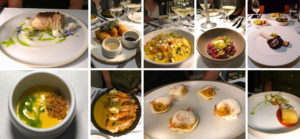
We spent the next morning at the Mercado Artesanal La Mariscal, a flea market located in the heart of Quito’s La Mariscal neighborhood. The market offers a wide variety of handicrafts and souvenirs that showcase Ecuador’s rich cultural heritage and artistic traditions. It is known for its colorful stalls, which are filled with handcrafted goods such as woven textiles, pottery, wood carvings, jewelry, and traditional Ecuadorian clothing. Visitors can browse through the many different stalls, negotiating with vendors and discovering unique treasures to take home as a souvenir. I purchased art showcasing a modern take on a traditional Ecuadorian landscape, that incorporated contemporary elements and techniques, including the use of bold colors, abstract shapes, or unexpected textures.
Then, in an impromptu decision, after ‘sufficient’ on-the-spot research, a few friends and I decided to get tattoos to commemorate our travel experience. I decided to have two small colourful sea turtles, a design that had been on my wish list for the longest time and a symbol of longevity, wisdom, patience, resilience, and determination. I was amazed by detailed job done by Ilse Tinoco at Triom Tattoo Studio.
After a quick stop at La Union (Panaderia y Pasteleria), a popular bakery and pastry shop, for coffee and desserts, we headed for an early dinner at Casa Gangotena, a fine dining restaurant located in the heart of Quito. The restaurant is situated inside the historic Casa Gangotena Hotel, which boasts an elegant and refined atmosphere, with classic decor, high ceilings, and large windows that offer a beautiful view of the Plaza San Francisco. We intended to enjoy the view from the rooftop patio, but due to the rainy weather, we decided to be seated in the indoor area that felt like a conservatory, with its glass ceiling, full of orchids and plants. My mission in Ecuador, looking back, had been to try the tartar dish almost at every restaurant I dined in. So naturally, I ordered that dish and the eggplant, which is another favourite flavour and they both felt like tasting heaven.
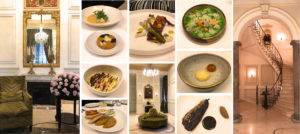
Some of our friends departed that night, so we were left in a more intimate group roaming around Mariscal Sucre, a vibrant and bustling neighborhood located in the heart of Quito, which is well-known for its nightlife and lively atmosphere, with numerous restaurants, bars, and clubs that cater to both locals and tourists alike. Additionally, the neighborhood is home to several museums, galleries, and theaters, showcasing both traditional and contemporary art and culture. Too indecisive about where to go, we decided instead to walk around and explore the neighborhood’s many historic buildings and architecture, including the iconic La Foch Plaza, which is surrounded by cafes, restaurants, and bars.
Upon returning to the hotel with my friends, and while lying in bed on the tenth (and top) floor, I started feeling the room swaying. We hadn’t had any drinks that night, so I knew this wasn’t due to my distorted perception. About 20 seconds in, I called my friends, who were staying next door to ask them: “Are you feeling this? Is this an earthquake?” And indeed, it was an earthquake of 5.8 magnitude, as it later turned out. Although earthquakes are never a good experience, somehow this one felt like a school trip where your friends end up showing up at your door in their pajamas past midnight to plot next steps full of excitement or in an adrenaline rush. When I opened my door to my friends, while trying to get dressed in a clumsy way, I saw other patrons heading to the staircase. My friend, who spoke the local language, asked them if it was serious enough and their response, even though I don’t speak Spanish, was pretty clear: “Evacuar!” Instead, we decided to stay in our rooms and go to sleep, trusting in Quito’s infrastructure to keep us safe. I didn’t even feel any of the follow-up earthquakes.
The Guapulo Neighborhood
The next morning, invigorated by the previous night’s happenings, we decided to relive it moment-by-moment by calling our other friends who were still in the city to chat over breakfast. We then headed to the Guapulo neighborhood and walked around the cobblestoned roads, and encountered a number of cafes and art studios which steeply winds down towards the Guapulo Church. We came across a charming little café, La Terraza de Guapulo, with a stunning view and unique decor. Situated on a hill, the café offered stunning views of the surrounding area and the city below. The atmosphere was cozy, with a rustic and natural decor that perfectly complemented the natural beauty of the area. We ordered local coffee, which came with fresh warm bread with butter and jam.
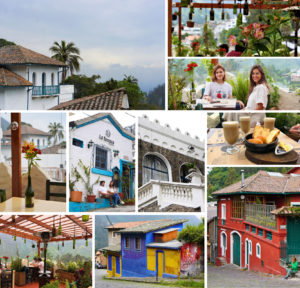
Virgin of the Panecillo
Trying to make the most out of our last day in Quito, we decided to skip the hike back up the hill and take advantage of the inexpensive Uber rides to visit the Virgin of the Panecillo, a monument that overlooks the city of Quito from atop a hill of the same name. The monument is an imposing figure, standing at a height of 41 meters and made entirely of aluminum. Built by Spanish artist Agustín de la Herrán Matorrast, it was inaugurated in the late 1970s and is one of the most recognizable symbols of Quito. It depicts the Virgin Mary with wings and a crown, standing atop a globe with a serpent at her feet, and is a symbol of the city’s deep Catholic faith, said to protect it from harm.
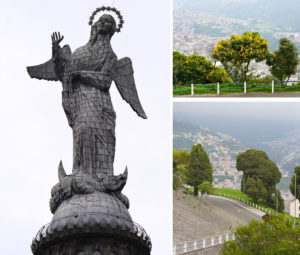
On the Hunt for Souvenirs
From the monument, we decided to take the stairs to descend back to the city. They cautioned us to look out for dogs on our way down but they turned out to be harmless. The views instead were gorgeous, as we stopped at every corner to take pictures. The best part about a trip where almost everything is planned is finding pockets of time to roam around the city and allow it to surprise you.
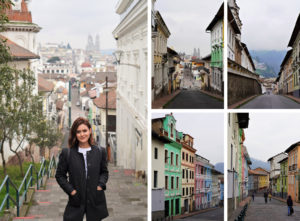
With absolutely no plan, on the last day, we allowed ourselves to get lost in the old city. At some point, it started raining and we weren’t carrying umbrellas, so we decided to wait it out inside Sombreros Lopez, a hat store established in 1920, where I purchased a Bigalli hat of impeccable quality, that I nonetheless haven’t worn yet.
Hidden Gems
Next, we headed to Chez Tiff Artesanal for souvenirs. When you step into the shop, you are immediately enveloped in the rich, chocolatey aroma that fills the air. The decor was warm and inviting, with rustic wooden shelves and display cases showcasing the various chocolate products. The shop offered a range of chocolate bars in different flavors and strengths, as well as other chocolate-based treats such as truffles and bonbons. The packaging of the chocolates was also beautiful, with colorful and intricate designs that reflect the rich cultural heritage of Ecuador. I really overdid it with the 90% cocoa dark chocolates made by Indemini Báez, which I brought back home.
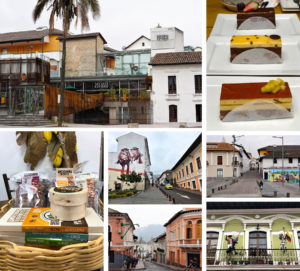
After that, we decided to have lunch next door, at Crustum 2850, a charming cafe with a stunning courtyard at La Casa Del Higo, where you can sit at tables surrounding a large fig tree. We were told by the locals that its desserts were renowned, and we could definitely see why.
Our last stop before heading back to the hotel was Yumbos, another chocolate shop that specializes in artisanal, handmade chocolate. The shop is located right across the street from Iglesia San Francisco. To access it you have to ring the bell at what seems like a residential building. We insisted quite a lot until we were let in. The shop is on the second floor facing an atrium. As soon as you enter, you see a large table with different chocolate samples feeling invited to taste everything. Yumbos sources its cacao from small farms in Ecuador and uses traditional techniques to produce their chocolate bars, truffles, and other confections. They also offer sessions on the history of chocolate. If you are not into chocolate, the panoramic view of the Plaza San Francisco from Yumbos’ balcony alone is so worth a visit.
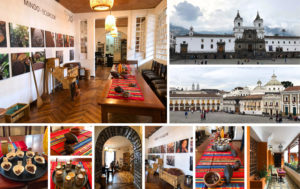
Overall, the experience was unforgettable. The old town of Quito – that gave European vibes – was charming and felt so familiar. The best part was visiting with friends and combining it with a memorable event. Naturally, a week was not enough to see everything. What I have on my list for the next time I visit is the Amazon rainforest staying at the Sacha Lodge, the Quilotoa Lake Crater Lagoon, and the Cotopaxi Glacier.

